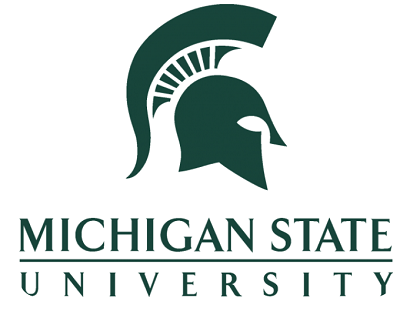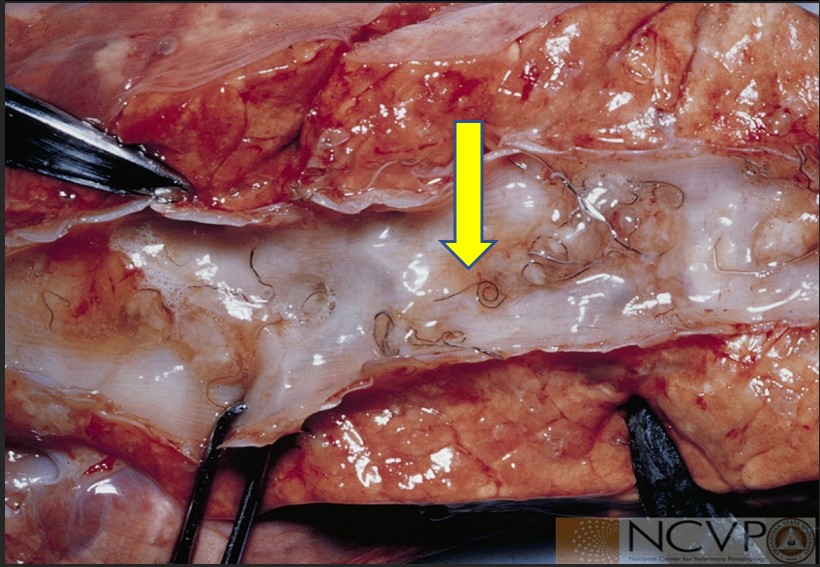

Pigs raised outdoors or on non-slatted floors are at risk for parasitic roundworms that can cause verminous pneumonia, a potentially fatal but preventable lung condition.

Verminous pneumonia is a serious condition that can occur in mammals when parasitic roundworms, including some species that infect pigs, invade the lungs. This can lead to frequent episodes of coughing and discomfort of the animal and sometimes cause death. In pigs, the cough caused by verminous pneumonia is often severe and associated with rapid, shallow breathing often referred to as thumping.
In pigs, verminous pneumonia is most frequently caused by the roundworm Ascaris. Eggs ingested from soil hatch in the intestine as larvae and penetrate through the intestinal mucosa entering the bloodstream. After arriving first in the liver and then in the lungs (Fig. 1), larvae cause inflammation and destruction of tissue due to eosinophilia and other immune reactions they evoke. In the liver, these reactions typically appear as white or “milk” spots on the surface. Ascaris larvae do not mature in the lungs but can cause destruction there both directly by inflammation or by way of secondary bacterial or viral infections that respiratory-compromised pigs are susceptible to.

Verminous pneumonia may also be caused by lungworms (Metastrongylus) that pigs can contract by ingesting infected earthworms or rodents. Once ingested, infectious stages of lungworms migrate directly to the lungs (Fig. 1) where they cause hemorrhaging. They may also complete their development to adult stage in the bronchioles and cause airway obstruction and severe coughing, resembling that caused by Ascaris larvae.
Verminous pneumonia can resemble other respiratory diseases
Farmers and show pig enthusiasts should know the clinical signs of verminous pneumonia and understand that this parasite-rooted disease can be challenging to differentiate from other respiratory infections caused by bacteria or viruses. Examples of the latter include Actinobacillus pleuripneumonia, Bordetella bronchioseptica, Haemophilus parasuis, Mycoplasma hyopneumonia, Pasteurella multocida or Streptococcus suis; respiratory viruses include Porcine reproductive and respiratory syndrome virus (PRRSv) and Swine influenza virus (SIV). Adding further complexity, as noted above, respiratory infection by Ascaris or lungworm can predispose an animal to secondary infection by one or more of the above bacteria and viruses. These secondary infections are more likely to occur in pigs exposed to challenging weather or other conditions that cause stress, including poor nutrition, lack of fresh water, over-crowding and being transported.
On presentation, an animal suffering from verminous pneumonia may be off-feed, appear gaunt and low on energy, and cough frequently, which may include thumping. These clinical signs may also appear early-on for PRRSv, SIV and each of the bacterial respiratory infections listed above. Fecal sampling for Ascaris eggs is easy to do and may be useful in older pigs but could easily yield a false negative in younger animals. Typically, laboratory testing of serum samples, nasal swabs or oral fluid samples are used to establish a preliminary diagnosis. Final diagnosis of verminous pneumonia in young animals due to infection by Ascaris, for example, usually requires a necropsy that reveals liver lesions which appear as white or “milk” spots and distinct multifocal hemorrhages coupled with firm, gray areas in the lungs, according to research conducted in 1932 by Schwartz and Alicata.
Deworming strategies to prevent verminous pneumonia
What steps can producers take to prevent verminous pneumonia? Unfortunately, effective and preventative vaccines for Ascaris and metastrongylus are not available, so prophylactic use of dewormers (anthelmintics) is the best treatment option available for preventing this condition. Although prophylactic or preventative use of dewormers may not be warranted in regions where Ascaris and lungworm exposure are low and may not be needed at all on intensive operations that raise pigs entirely on slatted floors, most farmers who raise pigs outdoors, on pasture or inside on non-slatted floors in Michigan would benefit from a routine deworming program. Prophylactic treatment can be timed to ensure that it will usually be the only control measure necessary, aside from practicing sound husbandry that includes providing proper nutrition and pasture rotation, to prevent serious infections. Several deworming products (anthelmintics) are highly effective against the adult stage of both Ascaris and lungworm. Key features of these products, which include fenbendazole (Safe-Guard) and avermectins (Ivomec, Dectomax), are summarized in Table 1. Michigan State University Extension provides this data for informational purposes only and does not endorse any single product listed.
Table 1. Dewormers that show consistent efficacy against nematodes that cause verminous pneumonia in pigs.
|
Parasite species (common name)
|
Fenbendazole (Safe-Guard®) |
Avermectin (Ivomec®) |
Levamisole (Tramisol®) |
Piperazine (Wazine®) |
Pyrantel (Banminth®) |
| Ascaris (roundworm) | + | + | + | + | + |
| Metastrongylus
(lungworm) |
+ | + | + | – | – |
| Formulations available for pigs | Feed pre-mix | Injectable or
feed pre-mix |
Water | Water | Feed pre-mix |
| Withdrawal period
(days) |
0 | 18 for injected
5 for pre-mix |
3 | 21 | 1 |
When considering a deworming strategy for your farm it is useful to keep two important points in mind: first, pigs raised outdoors or on pasture or inside on non-slatted floors may become reinfected continuously. Adult Ascaris can produce and shed up to a million eggs per day, and these eggs can survive in soil for as long as 15 years. Second, because the immune system in young pigs is not fully developed, they are less able to withstand infection than adults. With these points in mind, dose scheduling should be based on reproduction cycle and age of pigs. Sows are typically treated shortly before farrowing, before moving to clean farrowing units. Eliminating or reducing the number of worms in the sow prevents contamination of the farrowing area for piglets. This treatment should be supplemented by another treatment of the sows as well as gilts and boars at breeding. To further reduce risk of infection in piglets, your veterinarian may also recommend treating piglets at weaning and depending on pressure from worms in the environment, once or twice again during growing and finishing phases, as evidenced in research by Roepstorff and Nansen in 1998.
Other treatments for pigs with verminous pneumonia
An appropriate treatment strategy for a suspected or confirmed case of verminous pneumonia will depend on several factors including stage of disease, type(s) of secondary infection, for example, bacterial, viral or both, and number of animals affected. For infections involving one or a few animals, it is usually best to treat pigs as soon as possible using an injectable antimicrobial when bacterial infection of the respiratory tract occurs concurrently with suspected or confirmed roundworm infection. Using an injectable product allows the active agent to reach the lungs faster than a product given in-feed or water. It also provides greater certainty that the sick animal receives the full recommended dose of the antimicrobial used.
Show pigs can become infected
The threat verminous pneumonia can pose to show pigs is considerable, especially when pigs are housed outdoors. In some areas, show pigs are frequently purchased from out-of-area vendors who are unknown by the purchasing family. These pigs may already be infected. It is always wise to purchase your show pig from a reputable vendor, ideally a farmer in your area. Whether this is possible or not, be sure to ask vendors, especially those who raise pigs on pasture or non-slatted barns, to certify that the pig you purchase was dewormed at weaning, or that the sow was treated at farrowing; ideally, both preventive treatments would have been given.
After purchasing your pig, it is a good idea to administer a deworming product such as fenbendazole or avermectin shortly after arrival, before mixing with other pigs. This helps ensure both the health of your pig and its performance. Coupled with a three-week quarantine period, it also helps protect other pigs on your farm. If you are raising your pig outdoors or on non-slatted floors, it is also useful to deworm again at two-month intervals including a couple weeks before fair. Moving your pig from one pasture to another each month or so will reduce the level of egg contamination in the soil, and thereby reduce your pig’s exposure to infection. These simple steps will also help protect other pigs from infection who may come in contact with your pig, or a stool left by your pig at fair or shows. It will also protect you from the embarrassment of showing a pig that passes stool containing large white worms during fair week, reflecting poorly on your husbandry skills.
Recommendations for preventing and treating verminous pneumonia in pigs raised outdoors or on non-slatted floors
Your veterinarian is the best source of advice when it comes to preventing or treating parasite infections. Local conditions such as feeding/husbandry practices, weather and farm disease history coupled with evidence of drug-resistant strains of parasites can influence prevention measures recommended for your herd. The following tips should be viewed as suggestive or preliminary pending the advice of your local veterinarian.
- The most cost-effective and efficient way to prevent verminous pneumonia in your pigs is by practicing sound animal husbandry. This consists of ensuring the availability of plenty of fresh water and appropriate nutrition, and making sure animals are protected from extreme weather conditions. It also includes practicing sound biosecurity measures to minimize exposure to rodents and other wildlife known to spread parasitic and other diseases.
- Quarantine new arrivals for at least three weeks. If possible, rotate pastures every month or so to minimize exposure to eggs and larvae of Ascaris and lungworms that contaminate grass and soil.
- When recommended by your vet, vaccinate animals against the bacterial and viral diseases that are commonly associated with respiratory infection in your area.
- Implement a strategic deworming strategy that includes, when warranted, prophylactic use of a broad-spectrum anthelmintic that possess solid efficacy against Ascaris and lungworm. Pigs raised outdoors should be tested for worms or treated with an anthelmintic at two-month intervals. It is a good idea to rotate anthelmintics.
- On breeding operations, it may be useful to deworm sows about one week before farrowing. Wash sows thoroughly before moving to cleaned and sanitized farrowing crates.
- Treat a suspected or confirmed case of verminous pneumonia that is associated with a bacterial infection of the respiratory tract using an injectable antimicrobial agent that possesses confirmed activity against bacteria that cause respiratory disease in pigs. In some cases, your veterinarian may also prescribe a steroid to prevent further tissue damage of the infected/inflamed tissue.
- Your local veterinarian is the best source of information and advice for preventing or treating verminous pneumonia.
For additional information on how to prevent verminous pneumonia contact a member of the MSU Extension Pork Team.




